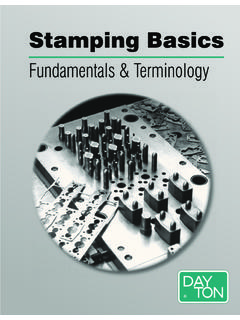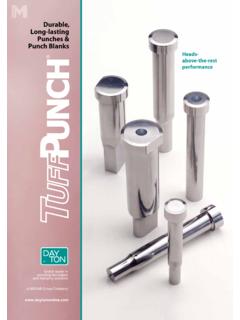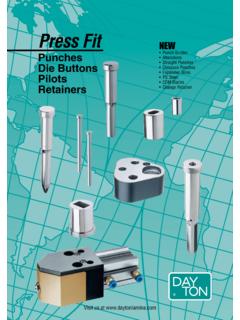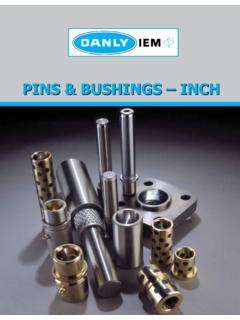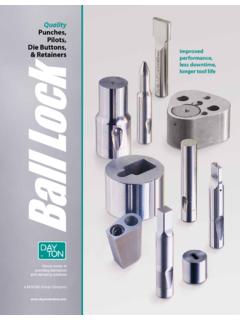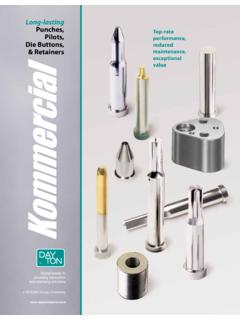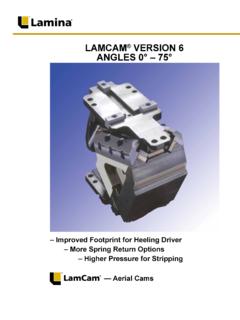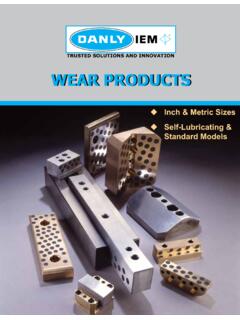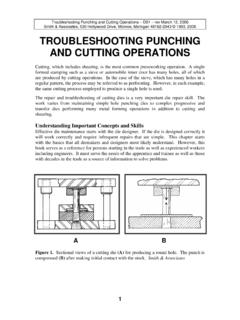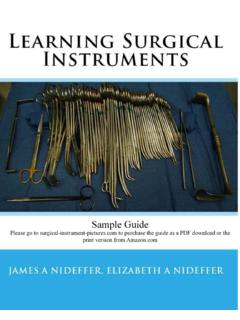Transcription of Stamping Basics - daytonlamina.com
1 Stamping Basics Fundamentals & Terminology 2. Introduction The Dayton Mission . It is the mission of Dayton Progress Corporation to continue furnishing our customers with the highest quality information, metal Stamping tools and precision components. Our over half century of surpassing delivery performance of the competition is our commitment to the future. This report defines basic Stamping terminology and illustrates basic Stamping functions. We explore the common types of die construction, compare Program Objectives stripper design options, and analyze common die operations. Describe Common Types of Die Construction. Compare Stripper Design Options. Analyze Common Die Operations. Punch Press Punch Press Perforation is generally the most severe operation performed in a die. That's because the punch press applies forces ranging from a few tons to more Die than 1000 tons. Proper press alignment is essential. While die set has some effect on alignment during operation, it cannot offset poor press alignment.
2 Simple Die Simple Die A simple die typically perforates holes in a part or blanks out the part using Perforating Punch punches in conjunction with mated lower die components (matrixes). Simple dies also commonly produce basic forms as well as perform notching and lancing operations. Stripper Simple dies require a press operator to load and unload parts and part Part material before and after each press cycle. Hand Fed One hit operation Matrix Matrix Retainer Secondary operations 2003 Dayton Progress Corporation, All Rights Reserved. DAYTON PROGRESS CORPORATION. 3. Compound Die Compound Die A compound die blanks and perforates a part at the same time in the same Perforating Punch station. In most cases this operation perforates a hole or holes down, while the part blanks up. This allows slugs from those holes to fall through the Part Knockout Blanking Die die. This method leaves the part in the die, requiring some means of part removal. Finished Part Compound dies commonly run as single-hit dies.
3 They can run continuously with a feeder, provided you can remove the part in a timely manner. Open Blanking Punch & Part Material Back Inclinable (OBI) presses - in the inclined position along with an air blow- Perforating Matrix off - aid in part removal. Washer die Stripper Perforating & blanking in one hit Leaves all burrs in one direction Advantages of a compound die include: Minimal space in the press All burrs in one direction Superior accuracy between holes and trim edges More economical to build than a progressive die A disadvantage of a compound blank die is its limited space that tends to leave die components thin and weak. This concentrates the load and shock on punches and matrixes, resulting in tooling failures. Progressive Die Progressive dies provide an effective way to convert raw coil stock into a finished product with minimal handling. As material feeds from station to station in the die, it progressively works into a completed part. Progressive dies usually run from right to left.
4 The part material feeds one progression for each press cycle. Early stations typically perforate holes that serve as pilots to locate the stock strip in later stations. There are many variations of progressive die designs. The design shown here illustrates some common operations and terminology associated with progressive dies. Stripper Designs Stamping dies require some means of stripping the part from the end of the punch at withdrawal. Common types of strippers for accomplishing this include Fixed, Urethane and Spring. Stripping force varies based on part material type and thickness as well as punch-to-matrix clearance. This force ranges from nearly zero to as much as 25% of the force required to perforate the initial hole. Most applications do not exceed 10% of the perforating force. DAYTON PROGRESS CORPORATION 4. Fixed Stripper Fixed strippers go by many names: Box Bridge Channel Positive Solid Tunnel A fixed stripper is a steel plate with a clearance slot that allows the part material to pass under it.
5 This plate mounts to the die retainer in a fixed position. Clearance holes cut through the stripper plate let the punches extend through without interference. At withdrawal the part material hits the stripper, preventing it from lifting as punches retract. The part material strips from the end of the punch. Fixed strippers have several drawbacks. They do not hold the stock strip flat and are unable to absorb impact and snap-thru shock. The result is poor part flatness and premature punch failure. We generally do not recommend fixed strippers for high-volume or high- precision jobs. A typical clearance under the stripper is 11 2 times the material thickness - 1/16 to 1/8 is common clearance on the sides of the stock strip. Clearance under a fixed stripper is commonly 11 2 times the part material. This allows for variations in part material thickness and for stock strip deformation. This deformation allowance under the punch point results in punch point chipping. That deformation can also cause lateral movement of both part and punches, resulting in punch point breakage and poor part quality.
6 At snap-thru there is a sudden unloading of pressure on the punches and part material. This generates shock, which can lead to punch head breakage. Note the buckling of the part material throughout the press cycle, as seen in. This can lead to dimensional and functional problems in the finished part. DAYTON PROGRESS CORPORATION. 5. The buckling effect binds the part on the ends of the punches, which increases stripping pressure and potentially chips the punch face. Urethane Stripper Urethane strippers are inexpensive and simple to use. They slide over the end of a punch with a slight press fit, which prevents the stripper from falling into the die during operation. Through use, urethane strippers fatigue and become loose on the punches. You must continually monitor them to prevent them from falling into and damaging the die. Some urethane strippers are molded with a head designed to fit a standard urethane retainer. This greatly enhances urethane stripper life and reliability.
7 Urethane stripper performance - especially during the bottom and withdrawal steps of the punch cycle - prompts special consideration before use. 1. Urethane does not compress. Under load urethane deforms. If the volume displacement necessary for this deformation exceeds the available space in the tool, the urethane stripper likely creates space by moving or breaking tooling components. 2. Because urethane does not provide a rigid flat surface, it cannot hold the stock strip or part flat. 3. Urethane strippers prevent air from venting in around the punch point or through the side vent hole of ejector punches, which can cause slug-pulling problems. Deformation and movement of the urethane strippers can move the stock strip or part laterally, creating punch-to-matrix alignment problems. A urethane stripper strips the part off the ends of the punches as it returns to it's original shape. Due to the urethane's pliable nature, the part material may distort during the perforating and stripping process.
8 Some urethane strippers have a steel washer attached to the end to minimize part distortion. Exercise caution when using this type of urethane stripper on shaped punches or applications where large amounts of pre-load are required. Catastrophic punch failure can occur if the punch face catches the steel face prior to hitting the part material. The optimum urethane stripper should have a combination of two different grades of urethane: a high hardness grade of urethane for the face and a medium hardness grade for the body. This helps maintain part flatness without sacrificing durability and elasticity. DAYTON PROGRESS CORPORATION 6. Spring Stripper Spring strippers offer superior performance. Their main advantage is that as the die closes, they hold the stock strip or part flat and in place during perforating. A spring stripper prevents the part material from lifting or hanging up on the punches at withdrawal. Because the stripper lifts away from the part material after each stroke, you can visually monitor die performance.
9 A spring stripper hangs below the ends of the perforating punches. As one of the first components to contact the part material, it holds the part in a fixed position throughout the cycle of the press. A spring stripper absorbs shock at snap-thru and eliminates shock at withdrawal that would otherwise damage the tooling and possibly the press. The main purpose of a stripper is to pull material from the ends of the punches. This function occurs at the withdrawal phase of the perforating process. Stripping force varies based on part material type and thickness as well as punch-to-matrix clearance. This force can range from nearly zero to as much as 25% of the force required to perforate the initial hole. Most applications do not exceed 10% of the perforating force. DAYTON PROGRESS CORPORATION. 7. Continuous pressure throughout the working portion of each press cycle provides superior performance in tool reliability, part quality and press life. Over-entry or closing a die below its recommended shut height can have catastrophic consequences.
10 Excessive stripper travel can: 1. Drive stripper screws into parallels or the press ram, potentially breaking the screws or bending the stripper. 2. Compress die springs beyond design limits, causing premature failure. 3. Cause stripper interference with the radius blend on the punches, resulting in broken punch points and heads. Punch over-entry also causes excessive galling and wear on the punch points. Stamping Terminology - Punch Operation Punches perform many functions. Some of the more common operations are shown at left. Perforating Perforating makes a hole by removing a slug. When perforating in a Stamping operation, a punch shears and breaks a slug out of the intended part material. The punch pushes the slug into a die hole (matrix). The matrix hole is larger than the punch point. A constant punch-to-matrix clearance is maintained around the entire punch point. DAYTON PROGRESS CORPORATION 8. To calculate tonnage requirements for perforating, multiply the part material thickness times the length of the cut, or perimeter of the hole, times the material shear strength (see Figure 18).
